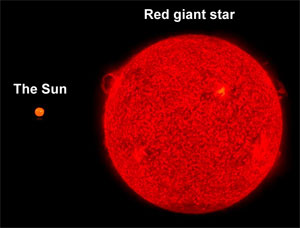I'm content that scientists understand that stars are the universe's Solar Element Generators.
And I giggle in wonder because our yellow sun is wonderfully stable.
But it'll die eventually.
Right now the sun is fusing hydrogen into helium in the plasma at its fusion core. Only in that violent state of matter, where atoms don't exist, can nuclei freely collide and rarely combine.
The process as shown above is oversimplified, but, eventually, the core will run out of hydrogen to fuse (but only if "run out" means that the hydrogen concentration drops below a critical level so the nuclei are too few and too far apart to collide often enough to fuse and release energy.)
Temperature is a measure of the average particle kinetic energy. More massive particles have lower speeds for the same kinetic energy or temperature. So if the star is to continue fusion, the temperatures must be higher so nuclei can collide with enough speed to overcome their positive-nucleus-to-positive-nucleus repulsion.
As the temperature in the core drops since not enough fusion energy is being produced, the star begins to shrink. The gravitational attraction of every particle for every other particle that formed our sun and planets now acts to pull the sun particles closer to each other.
As the sun compresses under huge gravitational forces, particles collide more often, speeds go up, and the temperature increases. Hydrogen fusion will shift to the outer layers of the sun and the sun will expand to become a red giant. After eating Mercury and Venus, our formerly friendly sun will consume the earth when it becomes a red giant.
After its hydrogen fusion phase, the sun will again gravitationally compress and heat up until its temperature is high enough that helium nuclei, the nuclear reaction product of the process pictured above, become the reactants. And the fusion products are carbon nuclei.
Eventually, of course, the concentration of helium will drop below the critical point and the sun will no longer be able to release energy from helium fusion. Carbon will fuse in this new white dwarf to make iron.
Iron will be the largest element that our sun make. Ever. Fe-usion.
Next the sun dies. But at least it'll never supernova. And it'll never become a black hole. But it's thousands of millions of years in the future so I'm not concerned.
Star life cycle in biography form
And in video form:


No comments:
Post a Comment